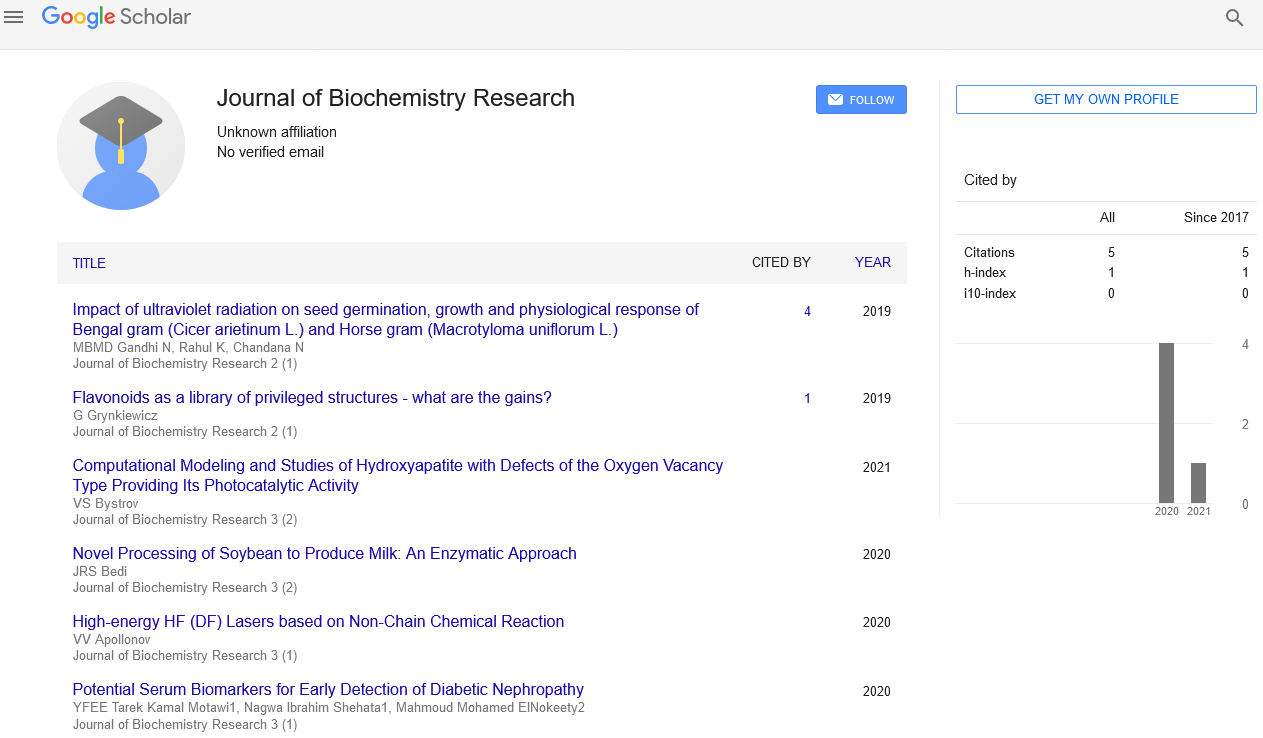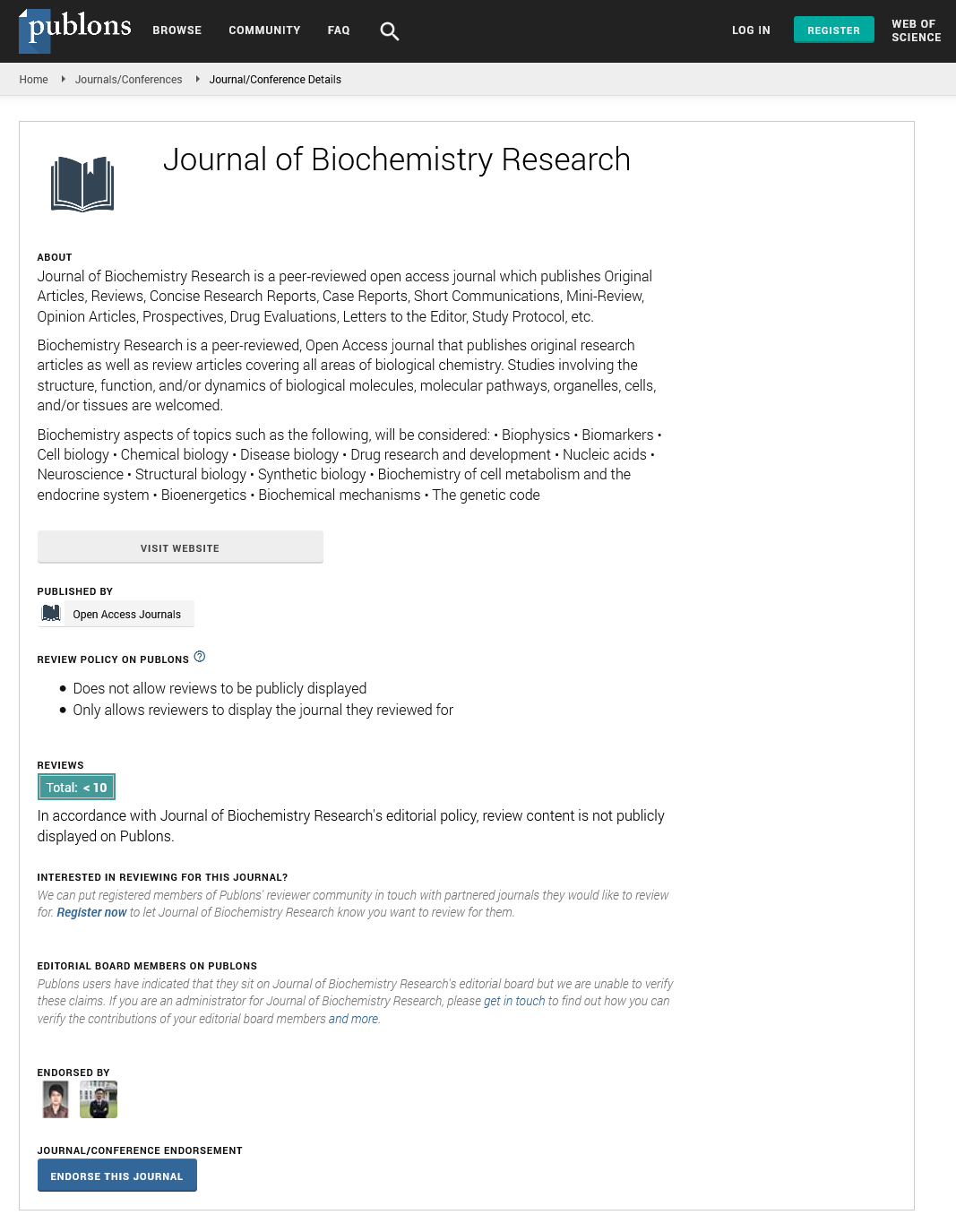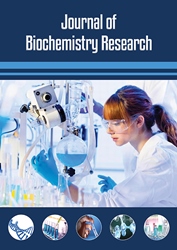Editorial - Journal of Biochemistry Research (2023) Volume 6, Issue 2
Biochemistry of lipid and carbohydrate biosynthesis
Dr. Daniel Brown*
Department of Biochemistry Research and carbohydrate, University of CMIS, Brazil
Department of Biochemistry Research and carbohydrate, University of CMIS, Brazil
E-mail: browndaniel@gmail.com
Received: 03-April-2023, Manuscript No. oabr-23-96862; Editor assigned: 05-April-2023, PreQC No. oabr-23-96862; Reviewed: 19-April-2023,QC No.oabr-23-96862; Revised: 21-April-2023, Manuscript No.oabr-23-96862 (R); Published: 28-April-2023; DOI: 10.37532/ oabr.2023.6(2).35-37
Abstract
Lipids and carbohydrates are two of the most essential classes of biomolecules, involved in a wide range of metabolic processes and biological functions. The biosynthesis of these molecules is tightly regulated and highly complex, involving a series of enzymatic reactions and intricate signaling pathways. Lipid biosynthesis begins with the conversion of acetyl-CoA, a key metabolite generated by the breakdown of glucose or fatty acids, into malonyl-CoA by the enzyme acetyl-CoA carboxylase (ACC). Malonyl-CoA serves as the substrate for the fatty acid synthase (FAS) complex, a multi-enzyme system responsible for the sequential condensation and reduction of acetyl-CoA and malonyl-CoA to produce saturated and unsaturated fatty acids. The final step in lipid biosynthesis involves the modification of these fatty acids into various classes of lipids, including phospholipids, triglycerides, and cholesterol. Carbohydrate biosynthesis, on the other hand, primarily involves the synthesis of glucose, the primary source of energy for many cells. Glucose biosynthesis, also known as gluconeogenesis, begins with the conversion of pyruvate, a key metabolite generated by glycolysis, into oxaloacetate by the enzyme pyruvate carboxylase. Oxaloacetate is then converted into phosphoenolpyruvate (PEP), which serves as the substrate for the enzymes involved in gluconeogenesis. The major regulatory steps in this pathway include the conversion of fructose-1,6-bisphosphate to fructose-6- phosphate by fructose-1,6-bisphosphatase, and the conversion of glucose-6-phosphate to glucose by glucose-6-phosphatase.
Keywords
Lipids and carbohydrates • Biomolecules • Metabolic processes and biological functions • Glucose or fatty acids • Acetyl-CoA and malonyl-CoA, gluconeogenesis • Fructose-1,6-bisphosphatase • Carbohydrate biosynthesis
Introduction
Biochemistry is the study of chemical processes and pathways in living organisms. Lipids and carbohydrates are two important classes of biomolecules that are involved in a wide range of biological processes. Lipids serve as structural components of cell membranes, energy storage molecules, and signaling molecules, while carbohydrates are involved in energy production, cell signaling, and cell recognition [1].
Lipid biosynthesis involves the synthesis of fatty acids, which are the building blocks of most lipids. Fatty acids can be synthesized de novo from acetyl-CoA, which is produced by the breakdown of glucose or other metabolic intermediates. The process of fatty acid synthesis is catalyzed by a multienzyme complex called fatty acid synthase, which is regulated by several key enzymes and hormones [2].
Carbohydrate biosynthesis, also known as gluconeogenesis, involves the synthesis of glucose from non-carbohydrate precursors such as amino acids, lactate, and glycerol. This process is important for maintaining glucose homeostasis in the body, particularly during fasting or lowcarbohydrate diets. The key enzymes involved in gluconeogenesis include pyruvate carboxylase, phosphoenolpyruvate carboxykinase, and fructose-1, 6-bisphosphatase [3].
Both lipid and carbohydrate biosynthesis are tightly regulated by a complex network of signaling pathways and feedback mechanisms. Key regulators of lipid biosynthesis include insulin, which stimulates the expression of genes involved in lipogenesis, and AMP-activated protein kinase (AMPK), which inhibits ACC activity in response to low energy levels [4]. Key regulators of carbohydrate biosynthesis include glucagon and cortisol, which stimulate gluconeogenesis by activating key enzymes in the pathway, and insulin, which inhibits gluconeogenesis by suppressing gene expression and activating protein phosphatases.
Biochemistry of lipid and carbohydrate biosynthesis
Lipids and carbohydrates are two of the major macromolecules that are essential for life. They are used for energy storage, membrane structure, and cellular signaling. In this article, we will explore the biochemistry of lipid and carbohydrate biosynthesis [5].
Lipid biosynthesis: Lipids are a diverse group of molecules that include fats, oils, waxes, and steroids. They are composed of three fatty acid chains and a glycerol molecule. Lipid biosynthesis occurs primarily in the liver and adipose tissue [6]. The process involves the synthesis of fatty acids, followed by the synthesis of triacylglycerols (TAGs) and phospholipids.
Fatty acid synthesis: Fatty acid synthesis occurs in the cytoplasm of the cell and is catalyzed by a multi-enzyme complex called fatty acid synthase (FAS). FAS consist of seven enzymes that work together to convert acetyl-CoA to long-chain fatty acids. The process of fatty acid synthesis requires a source of acetyl-CoA, which is derived from the breakdown of glucose in the cytoplasm. The acetyl-CoA is then converted to malonyl- CoA, which is the starting point for fatty acid synthesis [7].
FAS add two-carbon units to the growing fatty acid chain, using NADPH as a source of reducing equivalents. The process continues until the fatty acid chain reaches the desired length. The final product of fatty acid synthesis is palmitic acid, a 16-carbon saturated fatty acid.
Triacylglycerol synthesis: Once fatty acids are synthesized, they are used to synthesize triacylglycerols (TAGs) in the liver and adipose tissue. TAGs are used for energy storage and are the primary form of energy storage in the body [8]. TAG synthesis occurs in the endoplasmic reticulum and is catalyzed by several enzymes, including acyl-CoA: diacylglycerol acyltransferase (DGAT) and phosphatidic acid phosphohydrolase (PAP). TAG synthesis involves the addition of three fatty acid chains to a glycerol backbone. The process requires energy in the form of ATP and the addition of a phosphate group to the glycerol molecule. Once the TAG is synthesized, it is packaged into lipid droplets and stored in adipocytes.
Phospholipid synthesis: Phospholipids are a major component of cellular membranes. They are composed of a glycerol backbone, two fatty acid chains, and a phosphate group. Phospholipid synthesis occurs in the endoplasmic reticulum and involves the addition of a phosphate group to a diacylglycerol molecule. The process is catalyzed by several enzymes, including phosphatidylserine synthase (PSS) and phosphatidylcholine synthase (PCS) [9].
Carbohydrate biosynthesis: Carbohydrates are one of the primary sources of energy in the body. They are composed of simple sugars, such as glucose, fructose, and galactose. Carbohydrate biosynthesis occurs primarily in the liver and muscles and involves the synthesis of glucose and glycogen.
Gluconeogenesis: Gluconeogenesis is the process of synthesizing glucose from noncarbohydrate sources, such as amino acids and fatty acids. Gluconeogenesis occurs in the liver and is important for maintaining blood glucose levels during fasting or prolonged exercise [10]. The process involves several enzymes, including pyruvate carboxylase and phosphoenolpyruvate carboxykinase.
Glycogen synthesis: Glycogen is the storage form of glucose in the body.
Conclusion
The biosynthesis of lipids and carbohydrates is a highly complex and tightly regulated process that plays a critical role in the metabolism and function of living organisms. Understanding the molecular mechanisms underlying these pathways is essential for developing new therapies for metabolic disorders such as diabetes and obesity.
Lipid and carbohydrate biosynthesis are complex biochemical processes that play essential roles in cellular metabolism and physiology. A thorough understanding of these processes is important for developing treatments for metabolic diseases such as obesity, diabetes, and cardiovascular disease.
Lipid and carbohydrate biosynthesis are two essential metabolic processes that occur in all living organisms. Lipids are important for cell structure, energy storage, and signaling, while carbohydrates play a critical role in providing energy to the body and also serve as structural components in the cell. The biosynthesis of both lipids and carbohydrates is regulated by complex pathways involving multiple enzymes and intermediates. In lipids biosynthesis, the primary pathway involves the conversion of acetyl-CoA to fatty acids, followed by the assembly of fatty acids into complex lipids such as phospholipids and triacylglycerols. In carbohydrate biosynthesis, glucose is synthesized via the process of gluconeogenesis from non-carbohydrate precursors such as lactate, pyruvate, and amino acids. The regulation of lipid and carbohydrate biosynthesis is tightly controlled by a variety of factors including hormones, nutrients, and gene expression. Dysregulation of these processes can lead to metabolic disorders such as diabetes, obesity, and cardiovascular diseases.
Lipid and carbohydrate biosynthesis are essential metabolic processes that play critical roles in the maintenance of cellular structure and function. A better understanding of these pathways can lead to the development of new therapeutic approaches for the treatment of metabolic disorders.
References
- Carrillo JE, Carrillo VA, Perez HR et al. Defining and targeting health care access barriers. J Health Care Poor Underserved. 22, 562-75 (2011).
- Lewis RJ, Dutertre S, Vetter I et al. Conus venom peptide pharmacology. Pharmacological Reviews. 64, 259-98 (2012).
- Kobayashi H, Airway biofilms: implications for pathogenesis and therapy of respiratory tract infections. Respiratory medicine. 4,241-253 (2005).
- Makam AN, Nguyen OK. An Evidence-Based Medicine Approach to Antihyperglycemic Therapy in Diabetes Mellitus to Overcome Overtreatment. Circulation. 135, 180-195 (2017).
- Qaseem A, Vijan S, Snow V et al. Glycaemic control and type 2 diabetes mellitus: the optimal haemoglobin A1C targets, a guidance statement from the American College of Physicians. Annals of Internal Medicine. 147, 417-422 (2007).
- Bick David, Bick Sarah L, Dimmock David P et al. An online compendium of treatable genetic disorders. American Journal of Medical Genetics. Part C, Seminars in Medical Genetics. 187, 48-54 (2021).
- Lvovs D, Favorova OO, Favorov AV et al. A Polygenic Approach to the Study of Polygenic Diseases. Acta Naturae. 4, 59-71 (2012).
- Kobayashi H. Airway biofilms: implications for pathogenesis and therapy of respiratory tract infections. Respiratory medicine 4, 241-253 (2005).
- Jones G, Steketee RW, Black RE et al. How many child deaths can we prevent this year? Lancet. 362, 65-71 (2003).
Indexed at, Google Scholar, Crossref
Indexed at, Google Scholar, Crossref
Indexed at, Google Scholar, Crossref
Indexed at, Google Scholar, Crossref
Indexed at, Google Scholar, Crossref
Indexed at, Google Scholar, Crossref
Indexed at, Google Scholar, Crossref
Indexed at, Google Scholar, Crossref


